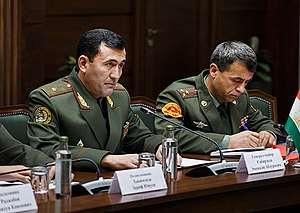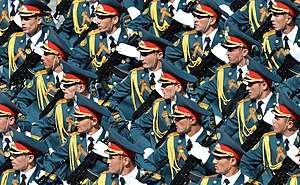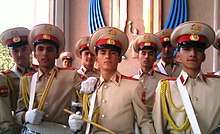Armed Forces of the Republic of Tajikistan
The Armed Forces of the Republic of Tajikistan (Tajik: Қувваҳои Мусаллаҳи Ҷумҳурии Тоҷикистон, Quvvahoi Musallahi Çumhurii Toçikiston), also known as the Tajik National Army (Tajik: Артиши миллии Тоҷикистон) is the national military of the Republic of Tajikistan. It consists of National Army, Mobile Forces, and the Air Force, with closely affiliated forces including the National Guard, border and internal troops.
| Armed Forces of the Republic of Tajikistan | |
|---|---|
| Қувваҳои Мусаллаҳи Ҷумҳурии Тоҷикистон (Tajik) Вооруженные силы Республики Таджикистан (Russian) | |
 The shoulder patch of the armed forces | |
 Roundel of Tajikistan | |
| Founded | 23 February 1993 |
| Service branches | Ground Forces Mobile Forces Air Force National Guard Security Forces ∟ Internal Troops ∟ Border Troops |
| Headquarters | Dushanbe |
| Leadership | |
| Supreme Commander-in-Chief | |
| Minister of Defense | |
| Chief of the General Staff | |
| Manpower | |
| Conscription | 18 years of age for compulsory military service; conscript service obligation – 2 years |
| Available for military service | 1,556,415 males, age 15–49 (2005 est.), 1,568,780 females, age 15–49 (2005 est.) |
| Fit for military service | 1,244,941 males, age 15–49 (2005 est.), 1,297,891 females, age 15–49 (2005 est.) |
| Reaching military age annually | 87,846 males (2005 est.), 85,869 females (2005 est.) |
| Active personnel | 85 000 |
| Reserve personnel | 120 000 |
| Expenditures | |
| Budget | 1 500 000 000 |
| Percent of GDP | 3.9 (2005 est.) |
| Industry | |
| Foreign suppliers | |
| Related articles | |
| Ranks | Military ranks of Tajikistan |
History
Unlike the other former Soviet states of Central Asia, Tajikistan did not form armed forces based upon former Soviet units on its territory. Instead, the Russian Ministry of Defence took control of the Dushanbe-based 201st Motor Rifle Division. Control simply shifted from the former district headquarters in Tashkent, which was in now-independent Uzbekistan, to Moscow. Also present in Tajikistan was a large contingent of Soviet border guards, which transitioned into a Russian-officered force with Tajik conscripts. For a long period a CIS peacekeeping force, built around the 201st MRD, were in place in the country.
On 23 February 1993, in the center of Dushanbe, the first military parade of militants of the Popular Front was held, which has since been considered the day the military formed.[1] Due to the presence of Russian forces in the country and the Civil war in Tajikistan, Tajikistan only formally legalised the existence of its armed forces in April 1994.[2] During the 1990s, the armed forces were often suffered from a poor commanded structure and poor discipline while their equipment was under-maintained. Draft-dodging and desertion was commonplace. Reflecting the fragmented militia group origin of the army's units, in late 1995 the Mahmud (1st) and Faizali (11th) Brigades of the Army exchanged fire several times, and fighting again broke out between the Army Rapid Reaction Brigade (formerly the Mahmud Brigade) and the Presidential Guard in June 1996. Colonel Khudoiberdiev, commander of the Rapid Reaction Brigade was relieved of his command as a result.
In 1999, the first military exercises of the Armed Forces were held in the Khatlon Garrison.[3] In September 2013, the Russian government has given the Tajik military $200 million worth of weapons and hardware, in return for letting them continue to use the 201st base. The National Drug Enforcement Agency of Tajikistan has received $5 million.[4]
Army


Tajikistan is the only former Soviet republic that did not form its armed forces from old Soviet Army units. Instead, the Russian Defense Ministry took direct command of the Soviet units there, forcing the Tajik regime to build an army from virtually nothing. During the 1990s, the army was small and had little amounts of native Tajiks in it. The army failed to effectively defend the regime, which resulted in a civil war. The regime was dependent on other Central Asian countries and CIS states on security, to the point that if they decided to withdraw their forces, the regime would collapse.
During the Tajik civil war (1992–1993), the Russian government had around 22,000 to 25,000 troops stationed in Tajikistan to help the regime as part of a defense agreement, which is why the Tajik government was able to survive the war. The war was often thought to have been started by Islamic fundamentalists, but more accurately, it was a war between the regional clans and ethnic groups.
The Tajik regime began assembling its own army in February 1993. The first units were drawn from the militias who fought in the civil war, allowing them to keep their ideologies and original commanders. That caused them to refuse to accept orders from higher authorities, and for skirmishes to break out between units. In early 1996, a rebellion occurred by the First Brigade of the Presidential Guard, after they fought and defeated the 11th Brigade. Though they were ultimately defeated in an attempt to take Dushanbe, the leader escaped to nearby Uzbekistan.
By the mid-1990s, the National Army numbered to around 3,000. The majority of the officer corps were Russian, mostly veterans of the war in Afghanistan. The Ministry of Defense of Russia continued providing material support for the National Army. It was especially difficult for the Army to create its own military force due to the fact that many Tajiks preferred to serve in the Russian Army, due to the higher pay. Because of military opposition in the country, the regime had the largest military buildup in the Central Asian region. As of 1997, Tajikistan had two motorized rifle brigades (one of them is a training brigade), a special operations brigade and detachment (all primarily intended for the protection of the ruling regime), and a combined aviation squadron. Tajikistan further had a basic set of units and sub-units that provide operational, technical, and logistic support.
Russia provided much support toward the creation of the national army, and trained command and engineer personnel. An institute of higher military education was created in Tajikistan. Despite the large budget (mostly from Russian taxpayer money) and the adequate training of personnel, the creation of the national army was proceeding very slowly. The army benefited from several United Tajik Opposition units that were experienced from fighting government forces during the civil war, but as of 2006, were poorly maintained and funded. At that time the army had 44 main battle tanks, 34 armored infantry fighting vehicles, 29 armored personnel carriers, 12 pieces of towed artillery, 10 multiple rocket launchers, 9 mortars, and 20 surface-to-air missiles.

The Tajikistan army in 2007 had two motorized rifle brigades, one mountain brigade, one artillery brigade, one airborne assault brigade, one airborne assault detachment, and one surface-to-air missile regiment. The airborne assault brigade is an elite special forces unit which Tajikistan has made a separate branch from the national army, the Tajik Mobile Forces. Some troops are trained by China, France, India, Russia, and the United States. The Peacekeeping Operations, or PKO Battalion, became one of the best units of the National Army due to it being trained by the National Guard of the United States in a partnership program. The US intended for the battalion to be sent as a peacekeeper unit along with other United Nations forces, perhaps in 2013.
The national army is being run in a Soviet-style. The American trainers are working on setting up a non-commissioned officer corps within the army to train enlisted personnel, though it is a process that will take time, and for the time being the officers train enlisted personnel. The United States government has decided that after ISAF troops pull out of Afghanistan, tens of millions of dollars worth of equipment will be given to the armies of Tajikistan and Uzbekistan, due to the fact that the Afghan National Army has ties to the Taliban and is not stable.[5]
Equipment
Mortars

Air Force
Throughout the 1990s, the military did not have an air force and relied on the Russian Air Force for air defense, however, the government planned on making one aviation squadron. In 2007, the Air Force had 800 troops and 12 helicopters. The organizational structure of the Air Force is unknown. Tajik airspace is patrolled by the Russian Air Force.
The Tajik Air Force remains small as Dushanbe doesn't expect an attack on Tajikistan from the air, and that Russian Air Force units at Gissar in Tajikistan and other such Russian contingents in Kazakhstan would detect any such assault. Tajikistan is also patrolled by Russian aircraft as part of the Joint CIS Air Defense System. The air force is mostly used for search and rescue missions, transportation, and the occasional attack on militant groups.
For funding, the government relied upon modest foreign funds. In February 2013, a 20th anniversary parade occurred in Dushanbe, celebrating the creation of the armed forces. During the parade, 20 helicopters flew over the city. India made a deal in which the Tajik and Russian Air Forces share an air base. The base is commanded jointly by Indian, Tajik, and Russian personnel, who rotate units there periodically.[8]
Because of the civil war, air force development was slow. The first equipment to arrive was 10 MI-8MTBs and 5 MI-24 in 1993 based at Dushanbe. The first transport aircraft were AN-24s(?) and AN-26s(?) were supplied in 1996. A plan from the 1990s to acquire SU-25s from Belarus to form an attack squadron did not occur. However, Moscow did help bolster the Tajik's helicopter contingents in 2006–07 by giving them six Mil Mi-8 and Mil Mi-24 Hind attack helicopters. It also provided four L-39 Albatros.
An accident occurred on 6 October 2010 when a Mi-8, military helicopter from the Tajik National Guard crashed in the Rasht Valley[9] close to Ezgand and Tavildara. The helicopter got caught in some power lines while attempting to land. The helicopter caught fire and crashed without survivors. This is the deadliest accident in Tajik aviation since 1997.
Aircraft Inventory
| Aircraft | Origin | Type | Versions | In service[6] | Notes |
|---|---|---|---|---|---|
| Mil Mi-24 Hind | attack | Mi-24 | 4[10] | ||
| Mil Mi-8 Hip | transport | Mi-8 | 11[10] | ||
| Tupolev Tu-134 Crusty | VIP | Tu-134A | 1[10] | ||
| L-39 Albatros | trainer | L-39C | 4[10] | former Russian[11] |
Mobile Forces
The Mobile Forces are the airborne troops of the armed forces. Similar to the Russian Airborne Troops, whom they perform training with, the Mobile Forces were created with no increase in military personnel by transferring a unit of the National Army. Although they are called paratroopers, the Mobile Forces often deploy out of helicopters, as the Tajik Air Force has few planes. In 2002, the Mobile Forces performed drills with special forces units from France, at Dushanbe International Airport. It led to the two nations planning greater military cooperation in the future.
A three-day joint training operation took place on 14 September 2006, known as Interaction 2006, with the Mobile Forces and the People's Liberation Army of China. The operation trained Chinese and Tajik troops in counter terrorism, crisis response, and strengthening the countries' capability of facing new threats. The training took place in the northern Khatlon province, at the Mumirak military base. The operation had two stages. The first included preparations for interactions between the two countries. The second focused on joint counter terrorism operations at the Mumirak range.
On 4 August 2007, the Ministry of Defence created a Paratroopers' Day to celebrate the Mobile Forces. A war game demonstration was held in Fakhrobod, some 30 kilometers south of Dushanbe, in which a Mobile Forces sub unit took part in taking out a terrorist group and freeing hostages. The war game was attended by senior officials of the Ministry, as well as other officers, politicians, and veterans of the Soviet invasion of Afghanistan.
In 2009, another war game occurred at Fakhrobod, this time led by instructors of the French Air Force. Using French aircraft, some 50 Mobile Forces and National Guard soldiers practiced parachuting from airplanes. In late 2011, France trained more paratroopers of the Tajik Military Institute, Mobile Forces, and National Guard. They jumped from C-160 aircraft.
On 27 September 2011, Tajikistan and Kyrgyzstan signed the plan of bilateral military cooperation for 2012 on the sidelines of the ongoing joint military exercise. Commander of the Mobile Forces, Major General Latif Fayziyev, was in overall command of the ongoing war game. A joint military exercise for subunits of the armed forces of Tajikistan and Kyrgyzstan as well as special police unit of Tajikistan was launched in the Tajik eastern Jirgatol district, Rasht Valley. The exercise scenario is based on surrounding a group of international terrorists in one of mountain gorges in Jirgatol on the Tajik-Kyrgyz border.
Another large group of international terrorists attempts to penetrate into Tajikistan from neighboring country to help the surrounded terrorists. Tajikistan and Kyrgyzstan launch a joint operation to annihilate the terrorists. The exercise that involved more than 600 servicemen of the Mobile Forces, National Army, and Border Troops and special police unit of the Interior Ministry's office for Rasht Valley as well as the operational group of Kyrgyzstan's Ministry of Defense along with armored vehicles and combat helicopters closed with a final phase featuring live-fire missions.
Later in 2012, the Mobile Forces performed training with the Collective Security Treaty Organization in the Chelyabinsk Oblast of Russia. A mountain company of the Mobile Forces as well as the special group of the Ministry of Defense took part in the war game. It ended in August 2012.[12]
National Guard

The Tajik National Guard is a special task force under direct command of the President of Tajikistan. Formed on 4 December 1992, it was originally a special forces unit known as the Brigade of Special Mission during the 16th session of the Supreme Council of Tajikistan, under the Tajik Interior Ministry. During its first years, the Guard underwent serious testing, which earned the trust of the President and the people. It was the reason why the President changed it from the Special Mission to the Presidential National Guard.
Their primary task is ensuring public safety and security. Within two years, four additional units were formed in the towns of Chkalovsk, Kalinin, and Obigarm. They had a similar structure to the rest of the military. Worthy of note is the honesty that the National Guard has exhibited. The Rapid Reaction Force, also called the First Brigade, under Colonel Mahmud Khudoiberdiyev, took part in the Tajik civil war, as part of the Guard and the regular Army. The colonel and his men fled into Uzbekistan. On 26 January 2004, the Presidential Guard was transformed into the National Guard.[13]
Security Forces
Border Troops
.jpg)
The Border Troops of Tajikistan are responsible for border security and operate often with the Afghan Border Police. Development of the border guard is overseen by the Organization for Security and Co-operation in Europe.[14] A Border Troops Academy is located in Dushanbe, while a Border Troops Training Centre is found to the south in the Rudaki District.[15] In 2011, the Border Troops, along with the National Army and Mobile Forces, took part in a joint war game with Kyrgyzstan on the Kyrgyz-Tajik border. The operation involved eliminating two attacking groups of terrorists.[12]
Internal Troops
The Internal Troops, formed on 28 December 1993, are tasked with state security, operating under the Interior Ministry. The also act as a reserve for the military, and are similar to the National Guard. They have a similar structure to the military.[16]
Allegations of Systematic violence against military conscripts
In June 2014 Global Voices Online reported that the practice of systematic violence against military conscripts (referred to as dedovshina) has risen to public awareness following a recent increase in incidences of manslaughter and suicides in the Tajik Army and the April 17, 2014 death of Akmal Davlatova who was beaten to death by his lance sergeant, Farrukh Davlatov.[17][18] Kidnapping of recruits was said to be a common practice in Tajikistan and victims have sometimes videotaped their own kidnappings.[17][19]
Foreign forces
Outside the Tajik military, thete are also significant foreign forces in the country, principally the Russian 201st Military Base of the Armed Forces of the Russian Federation. Another country with a military presence in Tajikistan is France, which formerly the Operational Transport Group of the French Air Force. It was designed to provide support to the French contingent in Afghanistan. The base was operated since 2002. In 2005, two French military transport aircraft and about 150 technicians/soldiers were deployed at the Dushanbe International Airport.[20] France used the space free of charge as a result of a bilateral cooperation agreement signed by Presidents Rahmon and Nicolas Sarkozy.[21] The contingent began to pull out in April 2013.[22]
In 2010, India took part in a multimillion dollar renovation of the Soviet-era Ayni Air Base near the Tajik capital. The completion of the renovation work at the base was marked by a military parade and a visit by President Rahmon.[23] Farkhor Air Base is directly operated by the Indian Air Force. It is the first military base outside its territory.[24] In 2003, Pakistani President Pervez Musharraf raised concerns to the Tajik government over the fact that Indian planes coming from the base would be able reach the border with Pakistan within minutes.[25]
Military education

Russia provided much support toward the creation of the national army, and trained command and engineer personnel. An institute of higher military education was created in Tajikistan. Despite the large budget and the adequate training of personnel, the national army was still far from a professional service.
The following are military educational institutions that are part of the Ministry of Defence and/or other militarized institutions:
See also
- Civil War in Tajikistan
References and links
![]()
- https://rus.ozodi.org/amp/27652827.html
- Jane's World Armies 2004
- https://www.tajmedun.tj/tj/nazare-ba/i-timoiyet/ba-ayratu-matonat-dalerivu-shu-oat-va-issi-balandi-millii-afsaronu-sarbozoni-bonangu-nomusi-vatan-bo/
- "Agreement on Russian military base submitted to Tajik parliament – RT Russian politics". RT. 18 September 2013. Retrieved 22 September 2013.
- John Pike. "Tajikistan- Army". GlobalSecurity.org. Retrieved 22 September 2013.
- John Pike (21 May 2013). "Tajik-Army Equipment". GlobalSecurity.org. Retrieved 22 September 2013.
- John Pike (21 May 2013). "Tajikistan - Army Equipment". GlobalSecurity.org. Retrieved 22 September 2013.
- John Pike. "Tajikistan- Air Force". GlobalSecurity.org. Retrieved 22 September 2013.
- Richard Kebabjian. "Accident Details". PlaneCrashInfo.com. Retrieved 22 September 2013.
- John Pike (21 May 2013). "Tajik Air force Equipment". GlobalSecurity.org. Retrieved 22 September 2013.
- "Janes Sentinel: Tajikistan Air Force". Janes.com. Archived from the original on 14 June 2012. Retrieved 22 September 2013.
- John Pike. "Tajikistan - References". Retrieved 24 December 2014.
- John Pike. "Tajikistan – National Guard". GlobalSecurity.org. Retrieved 22 September 2013.
- "Afghan and Tajik border guards complete patrol management course". Retrieved 24 December 2014.
- "OSCE". Retrieved 24 December 2014.
- "The law of the Republic of Tajikistan "About internal troops of the Ministry of Internal Affairs of the Republic of Tajikistan"". Retrieved 24 December 2014.
- Tajikistan's Army Chokes Young Draftees to Death, Posted 10 June 2014 8:57 GMT, http://globalvoices.org/2014/06/10/tajikistans-army-chokes-young-draftees-to-death/
- Radio Free Europe, 11 июня 2014, Таджикистан, Дело о «поперхнувшемся хлебом» солдате направлено в суд, http://rus.ozodi.org/content/article/25411009.html
- Youtube, Published on Apr 11, 2012, видео, добавленное с мобильного телефона, https://www.youtube.com/watch?v=ogYXVMin43A
- https://www.rferl.org/amp/1063989.html
- https://eurasianet.org/tajikistan-french-air-detachment-in-dushanbe-quietly-carries-out-afghan-mission
- https://eurasianet.org/french-military-begins-withdrawal-from-tajikistan
- https://www.rferl.org/amp/Tajik_Military_Air_Base_Completed_With_Indian_Help/2152731.html
- "India to station MiG-29 fighter-bombers at Tajikistan base". The Tribune. 22 April 2006. Retrieved 1 February 2012.
- "India to base planes in Tajikistan". The Tribune. 15 November 2003. Retrieved 1 February 2012.
- Jane's Information Group, Jane's World Armies, 2004 edition
- United Nations Secretary-General's reports on UNMOT, 1990s
- CIA World Factbook page
- Ҳифзи Ватан
| Wikimedia Commons has media related to Military of Tajikistan. |